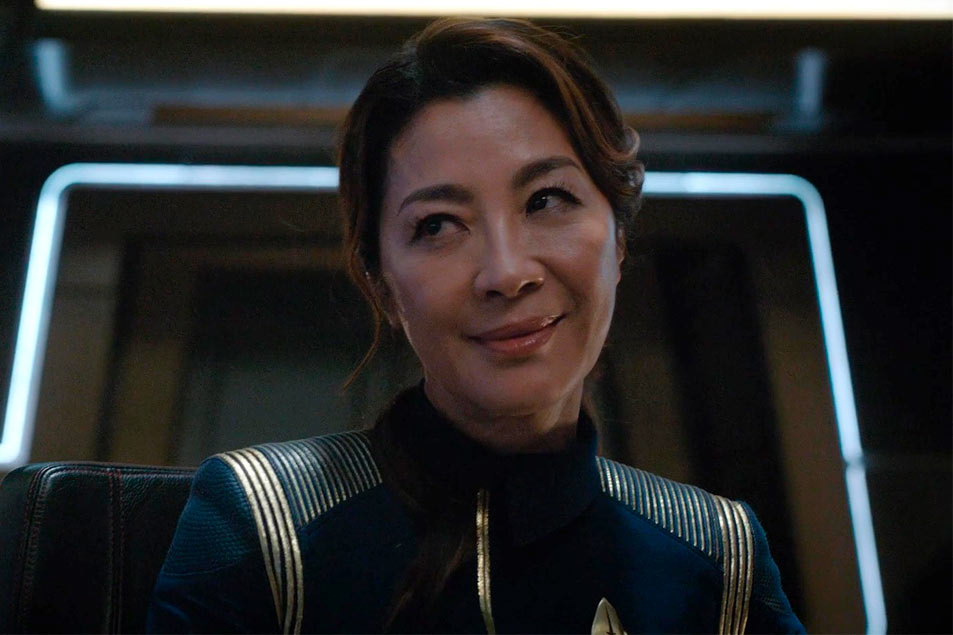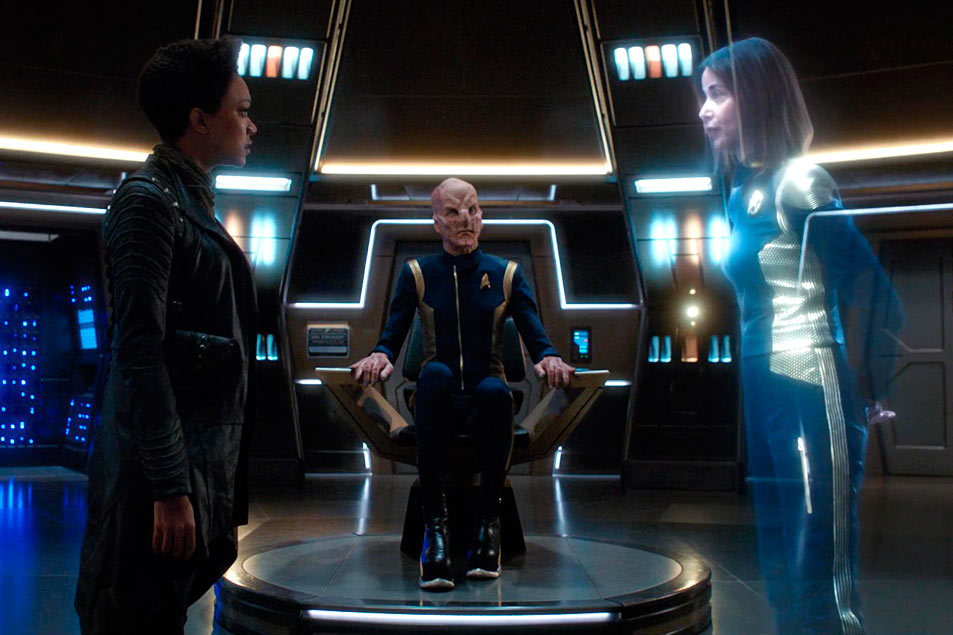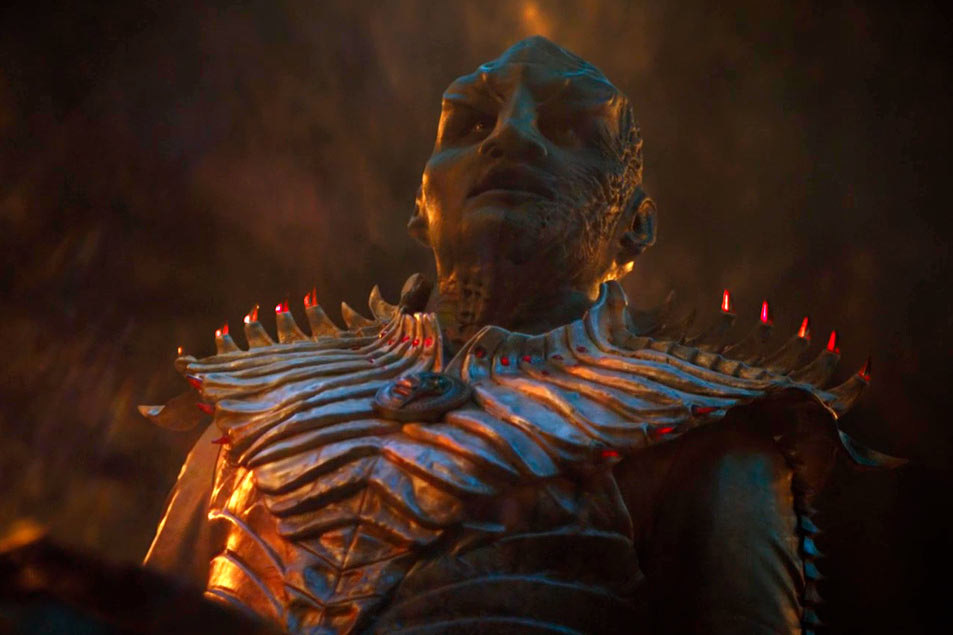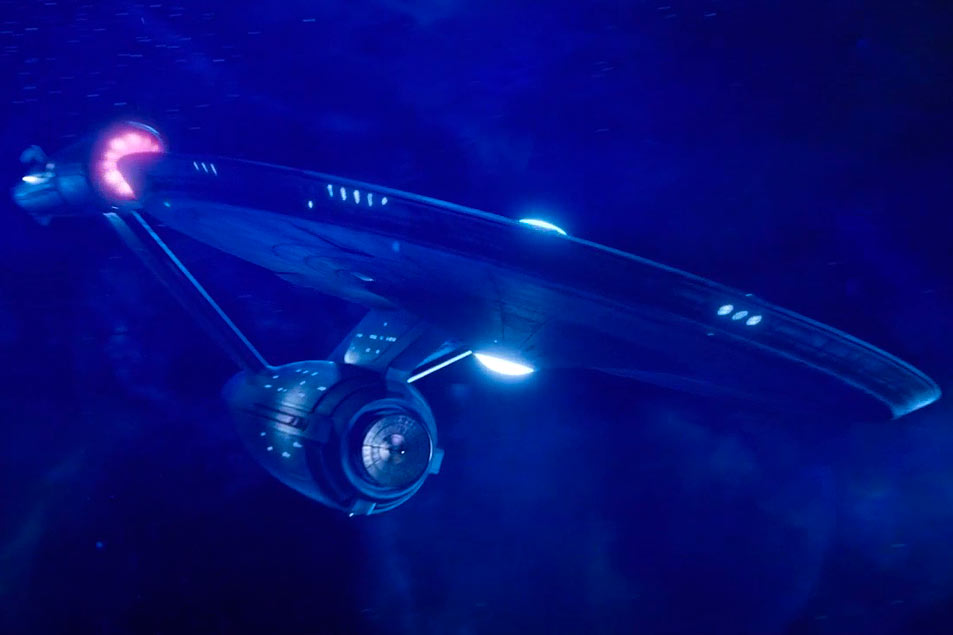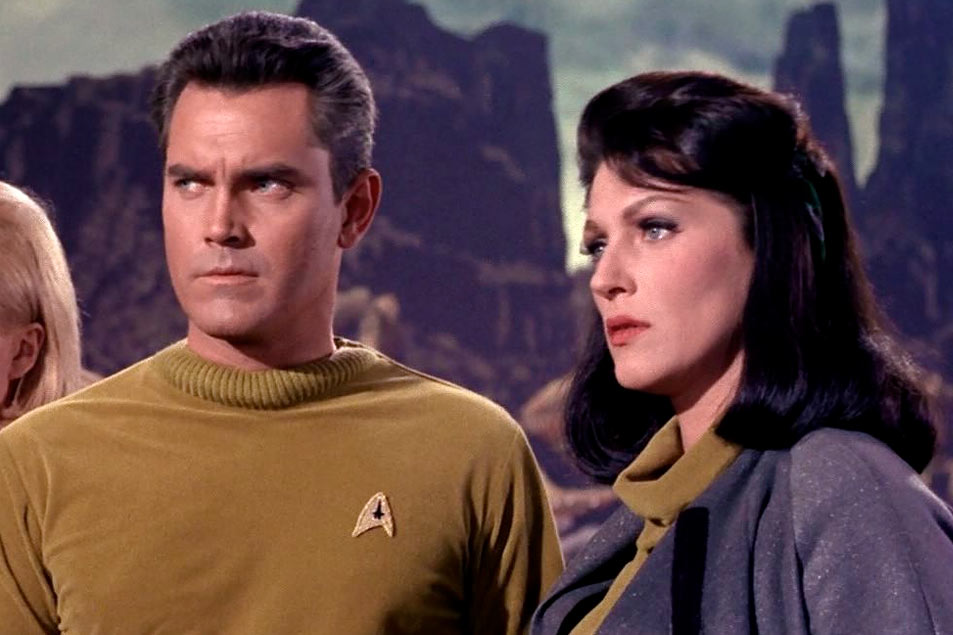“Will You Take My Hand?,” Discovery’s season one finale, opens with contrasting visuals of two very different worlds: Qo’noS and Earth. One is green and dark, the other blue and white and in the crosshairs of a fleet of marauding Klingons ready to strike at the heart of the Federation. We’re at the endgame of events set into motion 14 episodes ago at the Battle of the Binary Stars.
On the bridge of Discovery is another contrast. Philippa Georgiou sits once again in the captain’s chair of a Starfleet ship, but this is a very different woman than we met in the series opener. It’s not unusual for a Terran to captain the USS Discovery, but it is unusual for a Terran captain to be so forthright about their identity.
As entertaining in retrospect as Lorca’s deception was, I am equally glad to see Georgiou dispense with it. I scoffed when Terran Emperor Georgiou was introduced to Discovery’s crew as the Starfleet Captain Georgiou seemingly killed during the Battle of the Binary Stars. Surely the crew – especially the bridge crew, who would be working closely with the newly minted Captain Georgiou – wouldn’t be fooled by such a hasty switcheroo.
Implementing the plan formulated in “The War Without, The War Within,” Discovery jumps to Qo’noS and prepares to map the planet-wide system of dormant volcanic caverns. Upon arrival, Georgiou, Burnham, Tyler, and Tilly put on some fabulous mercenary outfits and beam to the surface. Before they can release the mapping drone that Tilly is carrying, they need to know the location of an ancient shrine built atop a dormant volcano.
During a walk through a grungy back alley that I’m going to call the Easter Egg District, we get among other references a food vendor selling grilled Ceti eels, as previous seen in The Wrath of Khan; a Trill getting a tattoo (possibly Emony Dax herself?); and Clint Howard, first seen on Star Trek way back in 1966 in his role as Balok, seated next to a punchbowl filled with an orange drink that looked suspiciously like tranya. I was genuinely surprised we didn’t see a four armed, piano playing woman belting out Klingon opera.
During their time on the surface, Tyler is in a unique position given that he retains all of Voq’s memories and is therefore familiar with much of what the away team encounters. He remains entirely Tyler – Voq, as a distinct entity, is definitely gone – but is able to draw on Voq’s memories, knowledge, and language skills to help the rest of the away team navigate their surroundings.
He also quickly and easily ingratiates himself with a group of gamblers, taking advantage of the novelty of a human who speaks impeccable Klingon. Shazad Latif’s acting in these scenes is particularly deft; at no point did I think the Voq persona was reasserting itself, but at the same time I could see and believe that Tyler was enjoying his surroundings.
I would imagine that trauma victims might sometimes struggle with the contradiction that routine familiarity, and even positive associations, can be intertwined with profoundly negative experiences. Latif balances Tyler’s sense of normalcy and regret while on Qo’noS with a subtlety that’s captivating to watch.
Though Burnham knows Tyler approached the gamblers for strategic purposes, hearing him enthusiastically bark out Klingon phrases and laugh his way through a game of t’Sang is particularly difficult for her. Initially her discomfort seems to stem primarily from her recent experiences with Tyler and Voq, but later we find that Burnham’s childhood trauma is the root cause of her reluctance to be on Qo’noS.
It’s not news that Burnham’s parents were killed by Klingons, but the details of the incident and its deep effect on her hadn’t been shared until now. I found it refreshing that, while Burnham’s relationship with Tyler certainly contributes to her inner conflict, it is neither the originating cause of the conflict nor the most significant aspect of it.
While Tyler and Burnham ask around for the location of the Molor shrine, Tilly and Georgiou split up. Georgiou slips off for a quick tryst with a pair of Orions, and Tilly awkwardly wanders into a drug den. Wanting to blend in and hopefully glean some intel from the other patrons, Tilly reluctantly agrees to take a mystery drug offered to her by an Orion played memorably by Clint Howard.
After Tilly passes out, the Orion tries to free the case from Tilly’s arm, causing her to awaken, open the case, and discover that what should be a mapping drone is actually a high-yield explosive. Georgiou reappears, takes the case from Tilly, and continues on what has been her plan all along: the complete destruction of all life on Qo’noS.
Personally, I wasn’t at all surprised when Georgiou’s apparent duplicity was revealed.
Even knowing she had been offered her freedom in exchange for her cooperation with Starfleet, it was clear from Michelle Yeoh’s performance that Georgiou had zero intention of doing anything she didn’t want to. No matter how big and important, an organization that operates under strict moral guidelines can’t effectively dictate terms to a psychopath.
As with the decision early on in the episode not to have Georgiou’s identity implausibly kept a secret, “Will You Take My Hand?” again chooses not to underestimate the intelligence of its characters. Starfleet, it turns out, isn’t as naive as it might have seemed, nor is it as strict in its sense of ethics. Georgiou hasn’t double-crossed anyone in trying to instigate genocide, she’s actually following direct orders from Starfleet, albeit orders she no doubt had a hand in developing.
Upon learning this chilling revelation from Admiral Cornwell, Burnham and the rest of Discovery’s bridge crew threaten to mutiny instead of carry out genocide. The Klingons are strong, but Federation ideals are stronger and Cornwell relents. It’s too late to retrieve the explosive from deep within Qo’noS, but Burnham has an idea that could not only avert mass destruction, but might also end the war without firing of a single shot.
Enter L’Rell. Thankfully for the people of Qo’noS, Georgiou cares more about her own wellbeing than the destruction of the Klingon race. Once she’s assured her freedom, Georgiou recodes the detonator controls to respond only to L’Rell and slips off into the night.
As with “The War Without, The War Within,” we’re again seeing Starfleet officers make decisions that probably seem to the average viewer to be, well, dangerously lenient. I was willing to look past my concerns in last week’s episode because the situation was relatively self-contained (Tyler was one man aboard a ship full of people looking out for him).
Letting a woman walk free, unsupervised, who just tried to wipe all life off the face of the planet and who feels herself entitled to interstellar dictatorial power is… a really bad idea. But I digress.
With the explosive in her control, L’Rell has the tool she needs to end the disorganized free-for-all that’s been the hallmark of Klingon aggression for the past nine months. Despite her outward aggression towards humans, L’Rell’s ultimate goal has always been the unification of the disparate Klingon houses into one cohesive empire.
The Federation’s perceived threat of diluting Klingon culture has already been achieved through infighting among the Klingons themselves. L’Rell is now essentially holding the entirety of Qo’noS hostage, and whether the High Council cares about Kahless is secondary – they care more not to be blown up.
At L’Rell’s insistence, Klingon forces withdraw from their positions near the Sol system, the first step in pursuing a more isolationist agenda. It seems as if the cold war seen in The Original Series is about to begin.
In what appears to be a parting gesture of peace between the Federation and the Klingons, Tyler decides at the last minute to stay on Qo’noS with L’Rell. I hope the reasons for and consequences of this decision are explored in Discovery’s second season; the parting was very sudden and the episode quickly moved on to its denouement.
Back on Earth, Burnham is addressing Federation dignitaries and Starfleet brass during a medal ceremony being held for Discovery’s crew. Beginning with the opening moments of “Will You Take My Hand?,” a Burnham voiceover has been running over the events of the episode.
The voiceover started abruptly and I found it to be a bit distracting, especially as it was unclear to me whether this represented Burnham’s inner thoughts in the moment, or an after-the-fact appraisal of the unfolding events. Once I saw that the voiceover was continuous with Burnham’s speech at the medal ceremony it made sense in retrospect, but I’d have appreciated an early flash forward to Burnham to give it more context.
Medals are handed out, congratulations are given, and Burnham’s record is formally expunged. After being officially reinstated as a commander aboard Discovery, it’s time for the ship to head to Vulcan where their new, unknown captain awaits. While on their way, however, Discovery picks up a garbled distress signal.
As Bryce dramatically decoded the Starfleet registration number of the distressed ship, I inched further and further to the edge of my seat; after the first two digits appeared – 1 and 7 – I was already on my feet.
There she is: the Enterprise. Everyone has lots of thoughts and feelings about Discovery’s rendering of the original NCC-1701, but I’ll keep mine brief. Overall, I like it.
I approve of the obvious design influences from the Enterprise NX-01, in my opinion one of the most photogenic ships in Star Trek’s long history, and I appreciate that other than a few minor tweaks – the neck between the saucer section and the secondary hull is shorter here than in the original design, and the ship has refit-era nacelle struts in 2257 – the iconic silhouette is unchanged.
Given Discovery’s production values and time period, I think this new version of the Enterprise is as close to the original as can be reasonably expected. A faithful recreation of the smooth, relatively undetailed Enterprise seen in The Original Series would run the risk of looking fake next to all the other highly detailed ships on the show.
My favorite moment of the season finale – and one of my top three moments of the entire season – doesn’t come until after the episode has already ended. I’m talking, of course, about Discovery composer Jeff Russo’s faithful rerecording of Alexander Courage’s original Star Trek theme. Not since Ron Jones’ iconic staccato strings in the final seconds of The Next Generation’s “The Best of Both Worlds, Part I” has a musical choice gotten me so excited to see what the next season of Star Trek will bring.
I will say, though, there’s something in my excitement about spending time with the Enterprise of Capt. Christopher Pike that has me a little worried. As much as I’ve enjoyed getting to know Discovery’s crew over the course of this season, I’m more immediately excited to spend time with my old friends aboard the Enterprise than I am with my new friends aboard Discovery.
Maybe this is unavoidable when dealing with a ship and crew drenched in nostalgia, but it’s something to think about. I’d be surprised if the Enterprise sticks around for more than a few episodes; from a production standpoint, filming two ships and crews for 15 episodes seems like it would be prohibitively expensive. If the Enterprise’s appearance is indeed a brief one, my concerns might be a nonstarter.
I don’t want to spend too much time indulging in wish lists or speculation, but I will say that of all the possibilities that come with a Pike-era Enterprise, the prospect of spending time with Number One is the thing I’m most excited about. Originally played by Majel Barrett in “The Cage,” Star Trek’s first pilot episode, Number One is Capt. Pike’s stoic, logical, and highly intelligent first officer (sound familiar?).
Though she was only around for one episode, Number One has always loomed large in my mind as a character whom I deeply admire; I’m really hoping we get to spend some time with her in Discovery’s second season. I have a feeling she and Burnham will get along mightily.
All in all, Discovery has put together a successful first season of television, especially by Star Trek standards. At times during the season I wasn’t convinced the show knew where it was going, but the last half of the season was especially strong, and these final two episodes gave an overall cohesion to the season that I wasn’t sure we’d get.
has a fine roster of actors, writers, and production staff; their passion for Star Trek is evident, and I can only imagine the show will get even better as the seasons progress.

